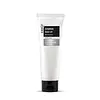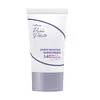What's inside
What's inside
 Key Ingredients
Key Ingredients

 Benefits
Benefits

 Concerns
Concerns

 Ingredients Side-by-side
Ingredients Side-by-side

Water
Skin ConditioningTitanium Dioxide
Cosmetic ColorantAluminum Hydroxide
EmollientStearic Acid
CleansingCyclomethicone
EmollientPEG-10 Dimethicone
Skin ConditioningIsohexadecane
EmollientZinc Oxide
Cosmetic ColorantMethicone
EmollientEthylhexyl Methoxycinnamate
UV AbsorberIsoamyl P-Methoxycinnamate
UV AbsorberCyclopentasiloxane
Emollient4-Methylbenzylidene Camphor
UV AbsorberGlycerin
HumectantCetyl PEG/PPG-10/1 Dimethicone
EmulsifyingDisteardimonium Hectorite
StabilisingIsononyl Isononanoate
EmollientBeeswax
Emulsion StabilisingOzokerite
Emulsion StabilisingSodium Hyaluronate
HumectantAloe Barbadensis Leaf Extract
EmollientCamellia Sinensis Leaf Extract
AntimicrobialCollagen Extract
Skin ConditioningMyrciaria Dubia Fruit Extract
Skin ConditioningMalpighia Emarginata Fruit Extract
Skin ConditioningMagnesium Sulfate
Hydrogenated Lecithin
EmulsifyingLinoleic Acid
CleansingCeramide NP
Skin ConditioningTea-Cocoyl Glutamate
CleansingCaprylic/Capric Triglyceride
MaskingCamellia Japonica Seed Oil
EmollientPhenoxyethanol
PreservativeEthylhexylglycerin
Skin ConditioningParfum
MaskingWater, Titanium Dioxide, Aluminum Hydroxide, Stearic Acid, Cyclomethicone, PEG-10 Dimethicone, Isohexadecane, Zinc Oxide, Methicone, Ethylhexyl Methoxycinnamate, Isoamyl P-Methoxycinnamate, Cyclopentasiloxane, 4-Methylbenzylidene Camphor, Glycerin, Cetyl PEG/PPG-10/1 Dimethicone, Disteardimonium Hectorite, Isononyl Isononanoate, Beeswax, Ozokerite, Sodium Hyaluronate, Aloe Barbadensis Leaf Extract, Camellia Sinensis Leaf Extract, Collagen Extract, Myrciaria Dubia Fruit Extract, Malpighia Emarginata Fruit Extract, Magnesium Sulfate, Hydrogenated Lecithin, Linoleic Acid, Ceramide NP, Tea-Cocoyl Glutamate, Caprylic/Capric Triglyceride, Camellia Japonica Seed Oil, Phenoxyethanol, Ethylhexylglycerin, Parfum
Water
Skin ConditioningHomosalate
Skin ConditioningEthylhexyl Methoxycinnamate
UV AbsorberAllium Cepa Bulb Extract
Skin ConditioningEthylhexyl Salicylate
UV AbsorberOctocrylene
UV AbsorberButyloctyl Salicylate
Skin ConditioningButyl Methoxydibenzoylmethane
UV AbsorberButylene Glycol
HumectantNiacinamide
SmoothingAcrylates Copolymer
Polymethylsilsesquioxane
C20-22 Alkyl Phosphate
EmulsifyingC20-22 Alcohols
Emulsion Stabilising1,2-Hexanediol
Skin ConditioningGlycerin
HumectantCaprylyl Methicone
Skin ConditioningPentylene Glycol
Skin ConditioningHouttuynia Cordata Extract
Skin ConditioningHydrogenated Lecithin
EmulsifyingCetyl Alcohol
EmollientDicaprylyl Carbonate
EmollientGlyceryl Stearate
EmollientSilica
AbrasiveTromethamine
BufferingPoly C10-30 Alkyl Acrylate
Emulsion StabilisingTitanium Dioxide
Cosmetic ColorantCoco-Caprylate/Caprate
EmollientDimethicone/Vinyl Dimethicone Crosspolymer
Skin ConditioningDimethiconol
EmollientTrisiloxane
Skin ConditioningPolyacrylate Crosspolymer-6
Emulsion StabilisingSodium Acrylate/Sodium Acryloyldimethyl Taurate Copolymer
Emulsion StabilisingPolyisobutene
Ethylhexylglycerin
Skin ConditioningKaolin
AbrasiveAdenosine
Skin ConditioningPolyhydroxystearic Acid
EmulsifyingXanthan Gum
EmulsifyingAlumina
AbrasiveTriethoxycaprylylsilane
Sorbitan Oleate
EmulsifyingCaprylyl/Capryl Glucoside
CleansingAllantoin
Skin ConditioningTocopherol
AntioxidantPanthenol
Skin ConditioningCaprylic/Capric Triglyceride
MaskingPolyglyceryl-10 Diisostearate
EmulsifyingGlycoproteins
Skin ConditioningMenadione
MaskingCI 77007
Cosmetic ColorantWater, Homosalate, Ethylhexyl Methoxycinnamate, Allium Cepa Bulb Extract, Ethylhexyl Salicylate, Octocrylene, Butyloctyl Salicylate, Butyl Methoxydibenzoylmethane, Butylene Glycol, Niacinamide, Acrylates Copolymer, Polymethylsilsesquioxane, C20-22 Alkyl Phosphate, C20-22 Alcohols, 1,2-Hexanediol, Glycerin, Caprylyl Methicone, Pentylene Glycol, Houttuynia Cordata Extract, Hydrogenated Lecithin, Cetyl Alcohol, Dicaprylyl Carbonate, Glyceryl Stearate, Silica, Tromethamine, Poly C10-30 Alkyl Acrylate, Titanium Dioxide, Coco-Caprylate/Caprate, Dimethicone/Vinyl Dimethicone Crosspolymer, Dimethiconol, Trisiloxane, Polyacrylate Crosspolymer-6, Sodium Acrylate/Sodium Acryloyldimethyl Taurate Copolymer, Polyisobutene, Ethylhexylglycerin, Kaolin, Adenosine, Polyhydroxystearic Acid, Xanthan Gum, Alumina, Triethoxycaprylylsilane, Sorbitan Oleate, Caprylyl/Capryl Glucoside, Allantoin, Tocopherol, Panthenol, Caprylic/Capric Triglyceride, Polyglyceryl-10 Diisostearate, Glycoproteins, Menadione, CI 77007
 Reviews
Reviews

Ingredients Explained
These ingredients are found in both products.
Ingredients higher up in an ingredient list are typically present in a larger amount.
This ingredient is an emollient, solvent, and texture enhancer. It is considered a skin-softener by helping the skin prevent moisture loss.
It helps thicken a product's formula and makes it easier to spread by dissolving clumping compounds.
Caprylic Triglyceride is made by combining glycerin with coconut oil, forming a clear liquid.
While there is an assumption Caprylic Triglyceride can clog pores due to it being derived from coconut oil, there is no research supporting this.
Learn more about Caprylic/Capric TriglycerideEthylhexyl Methoxycinnamate is an organic compound that provides UVB protection. It often goes by the more common name of octinoxate. It is created from methoxycinnamic acid and 2-ethylhexanol.
Ethylhexyl Methoxycinnamate absorbs UVB rays with wavelengths between 280-320 nm. UV absorbers protect your skin by using chemical reactions to convert UV rays into heat and energy.
UVB (290-320 nm) rays emit more energy than UVA rays. They are capable of damaging DNA, causing sunburns and are thought to be linked to skin cancer.
The state of Hawaii has banned sunscreens containing octinoxate due to its potential impact on coral reefs. More research is needed to bridge gaps in this research. The European Union allows higher levels of octinoxate in sunscreens than the US and Australia.
Ethylhexyl Methoxycinnamate is oil soluble. It is not stable and may lose efficacy when exposed to sunlight.
Learn more about Ethylhexyl MethoxycinnamateEthylhexylglycerin (we can't pronounce this either) is commonly used as a preservative and skin softener. It is derived from glyceryl.
You might see Ethylhexylglycerin often paired with other preservatives such as phenoxyethanol. Ethylhexylglycerin has been found to increase the effectiveness of these other preservatives.
Glycerin is already naturally found in your skin. It helps moisturize and protect your skin.
A study from 2016 found glycerin to be more effective as a humectant than AHAs and hyaluronic acid.
As a humectant, it helps the skin stay hydrated by pulling moisture to your skin. The low molecular weight of glycerin allows it to pull moisture into the deeper layers of your skin.
Hydrated skin improves your skin barrier; Your skin barrier helps protect against irritants and bacteria.
Glycerin has also been found to have antimicrobial and antiviral properties. Due to these properties, glycerin is often used in wound and burn treatments.
In cosmetics, glycerin is usually derived from plants such as soybean or palm. However, it can also be sourced from animals, such as tallow or animal fat.
This ingredient is organic, colorless, odorless, and non-toxic.
Glycerin is the name for this ingredient in American English. British English uses Glycerol/Glycerine.
Learn more about GlycerinHydrogenated Lecithin is created from the hydrogenation of lecithin (a group of phospholipids). Hydrogenation is a chemical reaction between hydrogen and another element.
This ingredient is an emollient and emulsifier. As an emollient, it helps soften skin by trapping moisture within. As an emulsifier, it prevents oil and water ingredients from separating.
Titanium dioxide is a mineral UV filter widely used in sunscreens and cosmetics.
It is one of only two UV filters officially classified as “mineral” by regulatory agencies, the other being zinc oxide.
Titanium dioxide provides broad-spectrum protection mostly in the UVB and UVAII range, with some protection in the UVAI range.
While its UVA protection isn’t as strong as zinc oxide’s, the difference is minor.
A common myth is that mineral UV filters reflect UV light. However, modern research shows titanium dioxide absorbs UV radiation like chemical filters (~95% absorption & 5% reflection).
Thanks to its non-irritating nature, titanium dioxide is suitable for sensitive, acne-prone, or redness-prone skin. It is unlikely to cause "eye sting" like other sunscreen ingredients.
A major drawback of this ingredient is its white cast and thick texture. This is why mineral sunscreens often leave a white cast and are less cosmetically elegant than chemical/hybrid sunscreens.
To improve white cast and spreadability, micronized or nano-sized titanium dioxide is often used.
There are ongoing concerns surrounding nano-titanium oxide's impact on marine ecosystems.
There is no conclusive evidence that any form of titanium oxide (or any other sunscreen ingredients) will cause harm to marine ecosystems or coral reefs. The science is still developing but many consumers are keeping a close eye on this issue.
Please note, many destinations have reef-safety sunscreen rules. For instance, the U.S. Virgin Islands advises all visitors to use non-nano mineral sunscreens.
Nano mineral sunscreens once raised safety concerns about absorption into skin.
Extensive research has shown that they do not penetrate healthy or damaged skin; they remain safely on the surface and the top layer of dead skin (stratum corneum).
You'll likely find titanium dioxide bundled with alumina, silica, or dimethicone. These ingredients help make titanium dioxide highly photostable; this prevents it from interacting with other formula components under UV light.
Learn more about Titanium DioxideWater. It's the most common cosmetic ingredient of all. You'll usually see it at the top of ingredient lists, meaning that it makes up the largest part of the product.
So why is it so popular? Water most often acts as a solvent - this means that it helps dissolve other ingredients into the formulation.
You'll also recognize water as that liquid we all need to stay alive. If you see this, drink a glass of water. Stay hydrated!
Learn more about Water